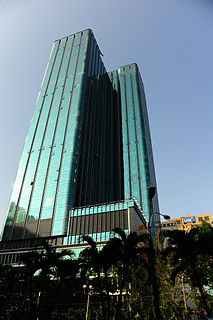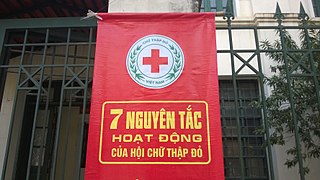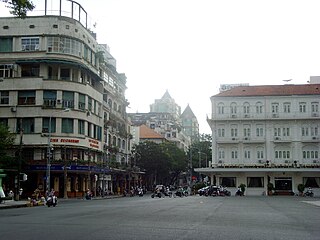
South Vietnam, officially the Republic of Vietnam, was a country in Southeast Asia that existed from 1955 to 1975, the period when the southern portion of Vietnam was a member of the Western Bloc during part of the Cold War. It first received international recognition in 1949 as the State of Vietnam within the French Union, with its capital at Saigon, before becoming a republic in 1955. South Vietnam was bordered by North Vietnam to the north, Laos to the northwest, Cambodia to the southwest, and Thailand across the Gulf of Thailand to the southwest. Its sovereignty was recognized by the United States and 87 other nations, though it failed to gain admission into the United Nations as a result of a Soviet veto in 1957.

Ho Chi Minh City, formerly known as Saigon, is the largest city in Vietnam, with a population of around 9 million in 2019. Situated in the southeast region of Vietnam, the city surrounds the Saigon River and covers about 2,061 km2 (796 sq mi).

The Viet Cong was an armed communist revolutionary organization in South Vietnam, Laos and Cambodia. It fought under the direction of North Vietnam, against the South Vietnamese and United States governments during the Vietnam War, eventually emerging on the winning side. It had both guerrilla and regular army units, as well as a network of cadres who organized peasants in the territory the Viet Cong controlled. During the war, communist fighters and anti-war activists claimed that the Viet Cong was an insurgency indigenous to the South, while the U.S. and South Vietnamese governments portrayed the group as a tool of North Vietnam. According to Trần Văn Trà, the Viet Cong's top commander, and the post-war Vietnamese government's official history, the Viet Cong followed orders from Hanoi and were part of the People's Army of Vietnam, or North Vietnamese army.

Major General Nguyễn Ngọc Loan was a South Vietnamese general and chief of the South Vietnamese National Police.

Chợ Lớn, usually Anglicized as "Cholon" in English sources, is a quarter of Ho Chi Minh City, Vietnam. It lies on the west bank of the Saigon River, having Bình Tây Market as its central market. Chợ Lớn consists of the western half of District 5 as well as several adjoining neighborhoods in District 6 and District 11. The quarter has long been inhabited by Chinese people, and is considered the largest Chinatown in the world by area.

The Fall of Saigon, also known as the Liberation of Saigon by North Vietnamese or Liberation of the South by the Vietnamese government, and known as Black April by anti-communist overseas Vietnamese was the capture of Saigon, the capital of South Vietnam, by the People's Army of Vietnam (PAVN) and the National Liberation Front of South Vietnam on 30 April 1975. The event marked the end of the Vietnam War and the start of a transition period from the formal reunification of Vietnam into the Socialist Republic of Vietnam.

Islam is one of the two main religions practised in Bosnia and Herzegovina, the other one being Christianity. It was introduced to the local population in the 15th and 16th centuries as a result of the Ottoman conquest of Bosnia and Herzegovina.
Lieutenant General Đặng Văn Quang popularly known as Fat Quang, was an officer of the Army of the Republic of Vietnam who served as a special advisor to President Nguyễn Văn Thiệu of South Vietnam.

The 1st Theater Sustainment Command is a major subordinate unit of US Army Central at Fort Knox, Kentucky.

Bánh canh are a thick Vietnamese noodles that can be made from tapioca flour or a mixture of rice and tapioca flour. "Cake" refers to the thick sheet of uncooked dough from which the noodles are cut.

French Cochinchina was a colony of French Indochina, encompassing the whole region of Lower Cochinchina or Southern Vietnam from 1862 to 1946. The French operated a plantation economy whose primary strategic product was rubber.

The Ho Chi Minh City Post Office, or the Saigon Central Post Office, is a post office in the downtown Ho Chi Minh City, near Saigon Notre-Dame Basilica, the city's cathedral. The building was constructed when Vietnam was part of French Indochina in the late 19th century. It counts with Gothic, Renaissance and French influences. It was constructed between 1886 and 1891 and is now a tourist attraction.

Times Square is a high-rise building in District 1, Ho Chi Minh City, Vietnam. This tower is a 40-storey joint tower and features a modern architectural style. Construction costs, invested by Times Square (Vietnam) Investment Joint Stock Company, totals approximately US$125 million. The height to the top of the tower is 164 m. The tower was once the third tallest building in Ho Chi Minh City after Saigon One Tower and Bitexco Financial Tower. Currently, Saigon Times Square ranks sixth in height in the city and 23rd nationally.
Indians in Vietnam consist of migrants to Vietnam from India, both historical and recent. As of 2011, there were about 2,000 people of Indian origin settled in Vietnam, mainly in Ho Chi Minh City. Prior to the Vietnam War, there was a vibrant Indian community consisting of primarily Tamils, and specifically the Chettiars.

The Viet Nam Red Cross Society is a member of the International Federation of Red Cross and Red Crescent Societies and has its headquarters in Hanoi. The organisation was established during the First Indochina War, and originally had two branches. The Northern branch was established in Hanoi in 1946, and the Southern branch was established by Dr Ho Van Nhut in Saigon in 1951.

The War in Vietnam, codenamed Operation Masterdom by the British, and also known as the Southern Resistance War by the Vietnamese, was a post–World War II armed conflict involving a largely British-Indian and French task force and Japanese troops from the Southern Expeditionary Army Group, versus the Vietnamese communist movement, the Viet Minh, for control of the southern half of the country, after the unconditional Japanese surrender.

Đồng Khởi Street, formerly rue Catinat is a street in District 1, Ho Chi Minh City, the former Saigon.

Nguyễn Thị Kim Ngân is a Vietnamese politician who served as the first female Chairperson of the National Assembly of Vietnam from 31 March 2016 to 30 March 2021. She was a member of the 12th Politburo of the Communist Party of Vietnam, in which she ranked second, after General Secretary of the Communist Party Nguyễn Phú Trọng. She previously served as Deputy Chairperson of the National Assembly of Vietnam.

Long Binh Post is a former U.S. Army base located in Long Bình, Đồng Nai between Biên Hòa and Saigon, Vietnam. The base functioned as a U.S. Army base, logistics center, and major command headquarters for United States Army Vietnam (USARV). Long Binh Post was also unofficially known as "Long Binh Junction, influenced by the widely used initials of then-President Lyndon B. Johnson.


















